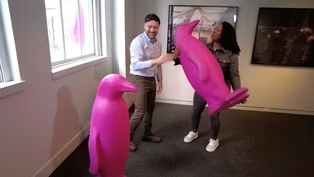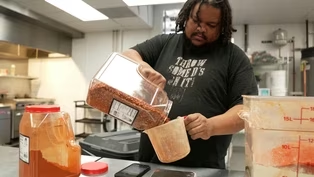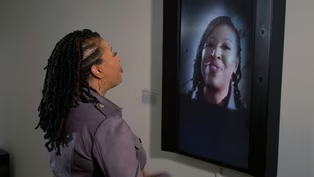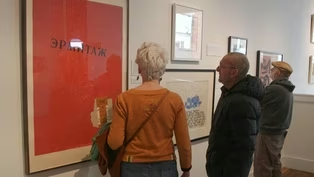
Crystal King Pottery
Clip: Season 21 Episode 15 | 5m 56sVideo has Closed Captions
Potter Crystal King keeps folk pottery traditions alive in Seagrove.
Meet potter Crystal King and see how she's keeping traditional folk pottery thriving in Seagrove.
Problems playing video? | Closed Captioning Feedback
Problems playing video? | Closed Captioning Feedback
North Carolina Weekend is a local public television program presented by PBS NC

Crystal King Pottery
Clip: Season 21 Episode 15 | 5m 56sVideo has Closed Captions
Meet potter Crystal King and see how she's keeping traditional folk pottery thriving in Seagrove.
Problems playing video? | Closed Captioning Feedback
How to Watch North Carolina Weekend
North Carolina Weekend is available to stream on pbs.org and the free PBS App, available on iPhone, Apple TV, Android TV, Android smartphones, Amazon Fire TV, Amazon Fire Tablet, Roku, Samsung Smart TV, and Vizio.
Providing Support for PBS.org
Learn Moreabout PBS online sponsorshipLet's head to Seagrove, the pottery capital of the country and meet Crystal King, a maker who's generating a lot of interest.
[gentle music] Crystal King applies a mane of clay to one of her signature lions.
- I always put a little tuck on the tail that was also done by the original.
- [Deborah] One of Seagrove's most celebrated artists, Crystal literally grew up in the Seagrove tradition.
- My parents, Anna and Terry King went to work with Dorothy and Walter Auman in the early eighties.
Dorothy was an eighth generation potter from here in Seagrove.
She was also one of the first women potters.
She married Walter Auman, who was from one of the other Seagrove legacy families, and together they opened the original Seagrove Pottery.
At five and six years old, when my parents went to interview with Dorothy and Walter to see if it would be a good working environment to apprentice with them, they left me in the back work area with a lump of clay.
[chuckles] A very first piece I hand sculpted, it was an elephant.
I remember it to this day and it was quite good.
They were very surprised when they came back in to see that I had made the piece on my own.
- [Deborah] In addition to functional pottery, the Aumans supported traditional styles and Crystal seemed to have a special talent for it.
- I think being an only child, I didn't have a lot of distractions, so I went everywhere with my parents early on to every show that they did, to visit all of the folk potters that they were interested in visiting.
So by 11 and 12 years old, I was already doing my sculpture work and I was selling at the same shows with them in their booth.
That gave me the sense of pride to continue doing it.
So very important and I guess in the young early years is that people were receiving my work in a way that made me proud enough to continue making and growing with my skill.
- [Deborah] When Crystal was just out of high school, her parents helped her open her own pottery shop.
- So it gave me space to kind of flourish and grow into my own artwork.
- [Deborah] Perhaps no other pottery tradition in the Seagrove area gathers more interest than face jugs.
It is believed that the first of these jugs were made in the mid 1800s by enslaved people in South Carolina.
During the mass production days of Seagrove, potters had little time to make face jugs, but they soon grew in popularity.
- Yes, if you're interested in face jugs, then we share something in common.
What's very interesting in face jugs is that with each family using a specific glaze, a specific firing technique, you can see in the characterization of that face jug, you can tell who made it.
This is a face jug that Terry King, my father made.
This is a melted piece of glass.
It was an old-timey form of decoration that was used by, in the old days, just a a piece of broken glass and it would flow down the piece, decorating it on its own.
We have little control over that, but that's the beauty of it.
And something I love that's a little secret, but my dad has a chin dimple and he often puts it in his jugs.
So I think that just brings a little bit of character to the piece that's unique to him.
- [Deborah] Remember the lion Crystal was working on?
It has a fascinating story.
- About the time that I was 14, a local collector who was well known had brought a postcard from Old Salem, and Old Salem at the MESDA Museum, they have a very important piece in pottery history.
It was one of the Solomon Bell lions from Winchester, Virginia, and it's a part of their permanent collection.
But when he brought in that postcard, he had asked my mother to make one of the lions.
And even then I thought, hmm, I do more animal sculpting than my mom.
If she doesn't make this piece, I'm gonna try it.
So eventually I did try the piece and made a few more and it got a lot of attention because it wasn't a historical piece that I was doing and it was an important piece that I was trying to mimic.
So that really inspired me and it became one of my signature pieces.
To this day, lions are a very important part of what I do, although I have blossomed out to, you know, I do all kinds of animals now, probably hundreds of different pieces.
- [Deborah] Despite the many hours Crystal spends on her craft and gallery, her passion for her art form and the community of Seagrove runs as fiery as the kilns she labors over.
- From the potters that were making thousands of pots and having to export them, basically through train, and wholesale to other areas, to having tourism that was coming in early in the 1920s and thirties because Seagrove was the only place, historically, making these type of pots and that we're still here a hundred years later doing the same thing and drawing people from all over the country to come see us as we live and work in this craft.
So it's really exciting to be a part of that and I really want the experience to be that when people walk in the shop, they're not just seeing a pot being made, you can buy pottery in many places, but what you're seeing here is a little part of two to 300 years of tradition that has evolved through that time into what you see today.
And if I can create that experience for them, that would really be what I desire to do.
[gentle music] - [Deborah] Crystal King Pottery is at 2475 North Carolina Highway 705 in Seagrove, and it's open Monday through Saturday from 10:00 AM to 4:00 PM.
For more information, visit Crystal's website at crystalkingpottery.studio And don't forget the annual Celebration of Spring pottery tour every April in Seagrove.
Video has Closed Captions
Clip: S21 Ep15 | 2m 12s | Check out the contemporary art at the 21c Museum Hotel in Durham. (2m 12s)
Video has Closed Captions
Clip: S21 Ep15 | 5m 37s | Mike De Los Santos brings his award winning barbecue and rubs to East Durham. (5m 37s)
Video has Closed Captions
Clip: S21 Ep15 | 5m 2s | Missy Lane’s Assembly Room is a social hub for music lovers in downtown Durham. (5m 2s)
Video has Closed Captions
Preview: S21 Ep15 | 21s | Meet artists, visit galleries and explore studios around the state. (21s)
Black Mountain College Museum and Arts Center
Video has Closed Captions
Clip: S21 Ep15 | 3m 51s | Black Mountain College is long gone, but a museum exploring its legacy lives on. (3m 51s)
Providing Support for PBS.org
Learn Moreabout PBS online sponsorshipSupport for PBS provided by:
North Carolina Weekend is a local public television program presented by PBS NC


















